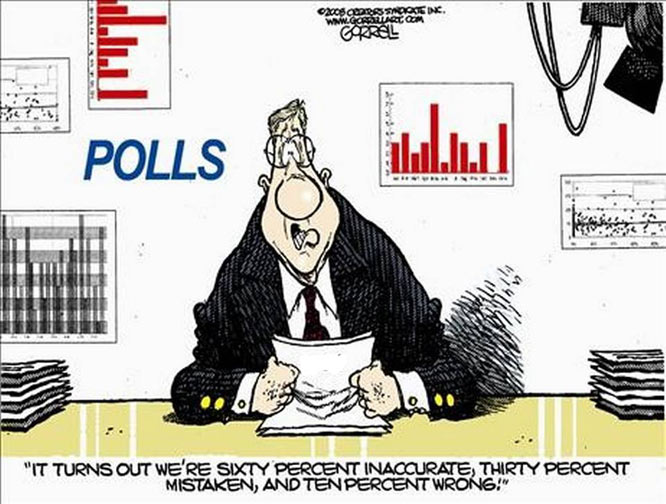
Were the polls wrong? It's a question asked after every election. Sometimes, as in 1948, the answer seems as obvious as the answer to the question, "Why did Custer lose at Little Bighorn?" Sometimes the answer is less obvious, as it is this year.
"The polls were skewed toward the Democrats," writes Nate Silver, who as proprietor of FiveThirtyEight has earned the distinction of being the nation's most assiduous polling analyst.
Silver gives short shrift to partisans — Democrats this year, Republicans in 2012 — who complained that polls were systematically biased against their side. The skew varies unpredictably, he says, perhaps because pollsters overcompensate in response to previous mistakes. He finds polls skewed against Democrats in 2006 and 2012 and against Republicans in 2002 and 2014 — all winning years for those parties.
Silver measures the skew by comparing the percentage margin for candidates in his website's average of the most recent pre-election polls to the percentage margin for candidates in the actual results. He finds that Republicans this year won bigger margins than in the polls in 24 of 36 Senate races and 28 of 35 governor's races.
Here's another way of looking at it, concentrating on those races that were seriously contested. In seriously contested Senate races — the chief event of this election cycle — the polls were quite accurate in presaging the percentages received by seven Democratic incumbents. Those Democrats ran from 3.2 percent ahead to 1.7 percent behind their RealClearPolitics polling averages. Also, three of the four Democrats running in open Democratic seats ran within that range of poll results.
Where the polls missed was in projecting Republicans' votes in Republican-held seats. Pat Roberts ran 10.6 percent ahead of polls in Kansas, Mitch McConnell 7.2 percent ahead in Kentucky and David Perdue 5.2 percent ahead in Georgia.
There's a similar but not identical pattern in seriously contested races for governor. In seven states where Democrats were defending governorships, Democratic nominees ran very close to the polls in five. Only in two close New England races, where polls had high undecideds, did they run further ahead.
In nine states with Republican-controlled governorships, Republicans all ran ahead of their poll numbers, from 3.2 percent in Alaska (where final results are not in at this writing) to 7.4 percent in Kansas.
All this suggests that pollsters did a better job of finding Democratic voters than they did of finding Republican voters. That accounts for the Democratic tilt in polling Silver finds when looking at candidates' percentage margins rather than percentage totals.
One possible reason is that Republican-leaning voters were more hesitant than Democratic-leaning voters about committing to vote for their party's candidates. The bulk of those undecided in polls in Kansas, Kentucky and most of the states with Republican governors were Mitt Romney voters in 2012.
There has been a similar phenomenon when pollsters ask people to rate the two parties' members of Congress. During most of this campaign cycle (but less so toward the end), Republicans in Congress were getting lower ratings than Democrats in Congress because more Republican voters gave their own party's members negative ratings.
Another possible reason, advanced by Henry Olsen of the Ethics and Public Policy Center, is that pollsters are doing a poorer job of sampling opinion in rural areas than in large metropolitan areas. Outside their states' three major metropolitan areas, Roberts won 63 percent of the vote, and McConnell won 61 percent. Polls seem to have missed this.
A third possible explanation — and all three may be overlapping — offered by RealClearPolitics analyst Sean Trende is that local pollsters were able, because of their greater experience and understanding of their states, to spot Republican trends that national pollsters missed. Trende credits the University of Arkansas poll, Ann Selzer's Des Moines Register poll in Iowa and Charles Franklin's Marquette University Law School poll in Wisconsin.
Pollsters face an increasingly difficult task. Telephone polling techniques were developed in a nation with universal landline phone service and a population that answered the phone when it rang. We no longer live in such a nation.
Only 9 percent of pollsters' calls resulted in completed interviews, the Pew Research Center reported in 2012. Maybe rural Republican voters are harder to reach or maybe they're too grumpy to commit until they have to.
In 1948, Gallup famously stopped polling eight days before the election, and "Dewey Defeats Truman" became one of history's most famous headlines. Gallup stayed in the field later after that had happened. The good news is that today's pollsters too can learn from experience.
Comment by clicking here.
JWR contributor Michael Barone is senior political analyst for The Washington Examiner.



 Contact The Editor
Contact The Editor
 Articles By This Author
Articles By This Author